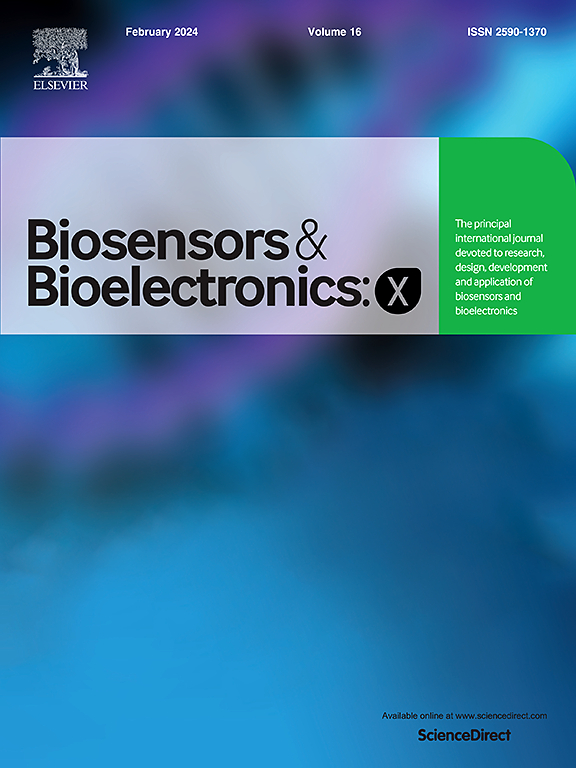CRISPR/Cas12-based signal-on lateral flow immunoassay for ultra-sensitive, selective, and rapid detection of human papillomavirus DNA in clinical samples
IF 10.61
Q3 Biochemistry, Genetics and Molecular Biology
引用次数: 0
Abstract
The trans-cleavage capability of CRISPR/Cas12a presents significant opportunities for the precise detection of double-stranded DNA (dsDNA). However, this potential has not been fully utilized in the context of lateral flow devices. This study introduced a novel, highly sensitive lateral flow assay that leverages the functionalities of CRISPR/Cas12a in conjunction with DNA probes to detect human papillomavirus (HPV) DNA, a primary etiological factor in cervical cancer, directly from clinical samples. The assay employed a DNA capture probe with specific sequences to construct both the control line using 40 thymine bases (T40) single-stranded DNA (ssDNA) and the test line utilizing 40 cytocine bases (C40) ssDNA, thereby effectively monitoring the presence of target DNA. In the mixed master reaction, CRISPR/Cas12a was combined with Biotin-GGGGGGGGGGAAAAAAAAAA (G10A10) ssDNA and introduced to a sample containing the HPV DNA. This process initiated a trans-cleavage mechanism, resulting in the conversion of Biotin-G10A10 ssDNA into Biotin-G10 ssDNA. By incorporating streptavidin-conjugated gold nanoparticles on the conjugate pad, the assay captured both Biotin-G10 ssDNA and any unreacted Biotin-G10A10 ssDNA at the test line and control line, respectively, leading to a distinct colorimetric appearance. Under optimized conditions, the assay demonstrated a detection limit of 0.2 copies/μL and exhibited excellent selectivity for HPV16 in clinical samples, correlating favorably with results obtained through gel electrophoresis. This innovative system not only underscores the considerable potential for rapid, sensitive, and specific detection of HPV DNA, but it also serves as a promising prototype for further advancements in nucleic acid-based detection methodologies.

基于CRISPR/ cas12的信号侧流免疫分析法用于临床样品中人乳头瘤病毒DNA的超灵敏、选择性和快速检测
CRISPR/Cas12a的反式切割能力为精确检测双链DNA (dsDNA)提供了重要的机会。然而,这种潜力尚未在横向流动装置中得到充分利用。本研究引入了一种新颖的、高度敏感的横向流动检测方法,该方法利用CRISPR/Cas12a的功能与DNA探针结合,直接从临床样本中检测人乳头瘤病毒(HPV) DNA, HPV是宫颈癌的主要病因。该方法采用带有特定序列的DNA捕获探针,构建含有40个胸腺嘧啶碱基(T40)单链DNA (ssDNA)的对照系和含有40个细胞素碱基(C40) ssDNA的检测系,从而有效监测目标DNA的存在。在混合主反应中,将CRISPR/Cas12a与生物素- ggggggggggggaaaaaaaaa (G10A10) ssDNA结合,引入到含有HPV DNA的样品中。这一过程启动了反式裂解机制,导致生物素- g10a10 ssDNA转化为生物素- g10 ssDNA。通过将链霉亲和素结合的金纳米颗粒结合到共轭衬底上,该实验分别在测试线上和对照线上捕获生物素- g10a10 ssDNA和任何未反应的生物素- g10a10 ssDNA,从而获得独特的比色外观。在优化条件下,该方法的检出限为0.2拷贝/μL,对HPV16具有良好的选择性,与凝胶电泳结果吻合良好。这一创新系统不仅强调了快速、敏感和特异性检测HPV DNA的巨大潜力,而且还为进一步发展基于核酸的检测方法提供了一个有希望的原型。
本文章由计算机程序翻译,如有差异,请以英文原文为准。
求助全文
约1分钟内获得全文
求助全文
来源期刊

Biosensors and Bioelectronics: X
Biochemistry, Genetics and Molecular Biology-Biophysics
CiteScore
4.60
自引率
0.00%
发文量
166
审稿时长
54 days
期刊介绍:
Biosensors and Bioelectronics: X, an open-access companion journal of Biosensors and Bioelectronics, boasts a 2020 Impact Factor of 10.61 (Journal Citation Reports, Clarivate Analytics 2021). Offering authors the opportunity to share their innovative work freely and globally, Biosensors and Bioelectronics: X aims to be a timely and permanent source of information. The journal publishes original research papers, review articles, communications, editorial highlights, perspectives, opinions, and commentaries at the intersection of technological advancements and high-impact applications. Manuscripts submitted to Biosensors and Bioelectronics: X are assessed based on originality and innovation in technology development or applications, aligning with the journal's goal to cater to a broad audience interested in this dynamic field.
 求助内容:
求助内容: 应助结果提醒方式:
应助结果提醒方式:


